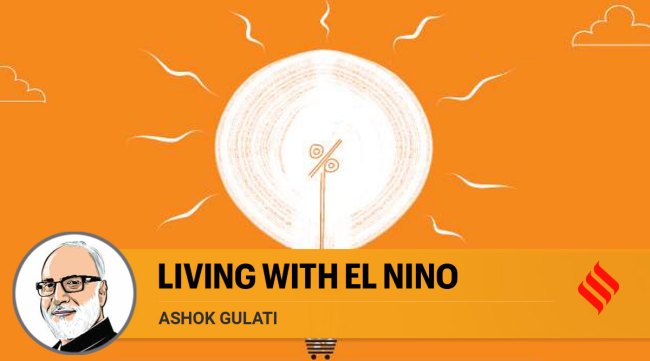Opinion Ashok Gulati writes: How food inflation can be managed keeping El Nino in mind
It can be kept under check if India uses trade policy wisely, and does not resort to knee-jerk methods
 The prospect of El Nino hitting India sometime towards the later half of monsoon season has created a new uncertainty about kharif crops.
The prospect of El Nino hitting India sometime towards the later half of monsoon season has created a new uncertainty about kharif crops. Let me start by complimenting the Reserve Bank of India (RBI) team, especially its Monetary Policy Committee (MPC) for “the pause” in raising repo rates in its last meeting. RBI Governor Shaktikanta Das put it very appropriately when he said that the decision should be seen as a pause, not a pivot, and the Bank is open to any further increases in repo rates if inflation remains defiant.
Although this pause was against the majority view in the market, it has served two important purposes: One, it has clearly shown that the RBI is not blindly following the US Fed in raising interest rates to tame inflation; and two, it reflects RBI’s confidence in containing inflation below 6 per cent while keeping overall GDP growth well above 6 per cent. I hope this confidence turns into reality, which it can if India follows the right policy mix. What could that policy mix be?
Before we get into the policy mix, let us understand the nature of CPI inflation, and how it is likely to behave if India is hit by El Nino, and if monsoon remains at 96 per cent or 94 per cent of the Long Period Average (LPA) as predicted by IMD and Skymet lately.
The CPI data of March 2023 reveals that inflation has dropped to 5.66 per cent (y-o-y), which is below the upper limit of RBI’s tolerance band of 4 per cent +/- 2 per cent. Interestingly, this drop in overall inflation has been significantly brought about by food inflation (CFPI), which is at 4.79 per cent. Vegetables price inflation is in the negative zone at -8.51 per cent, followed by oils and fats at -7.86 per cent. This has caused some stress to onion farmers where prices dropped by more than 30 per cent (y-o-y), potato prices dropped by 20 per cent and mustard prices are ruling well below their minimum support prices (MSP). Maharashtra has extended some support to onion farmers. But much more is needed to safeguard farmers’ interests. Yet, for RBI, it has turned out to be timely in containing inflationary expectations, which is the need of the hour.
However, even in food, inflationary concerns remain high in case of cereals, milk and milk products, and spices where inflation is still roaring at 15.3 per cent, 9.3 per cent, and 18.2 per cent, respectively. Milk and milk products has the highest weight in CPI and so, contributes the most to CPI inflation. It may be worth noting that the milk production in the country, which normally has been growing at 5 to 6 per cent per year over the last few years, suddenly came to almost a halt in FY23 with overall production at 222 million tonnes (mt) against 221mt achieved in FY22. This has been attributed to the lumpy skin disease that has impacted a large number of animals. Although the recent reports suggest that growth in milk production is gaining momentum, it will take time to cool milk prices.
Amul has raised its prices three times and Mother Dairy even more in a single year. In such a situation, the only logical option in the short term to contain milk prices seems to be reducing import duties on skimmed milk powder (SMP) and butter to about 15 per cent. In the medium to long run, the GoI should have a plan to augment good quality fodder supplies and raise productivity of milch animals.
But what about cereals? Wheat inflation (non-PDS) is still roaring at about 20 per cent, though it is likely to come down in the next two months as harvesting and procurement picks up in Punjab-Haryana belt. The unseasonal rains in March end played spoilsport, and created uncertainty about the wheat output. While the government is yet to finalise its numbers about wheat output loss, private trade has already started discounting the production target of 112 mt by 4 to 5 mt. In this situation, the government can lower import duties on wheat and let traders import if they find it cheaper. The bottom line is that there should be ample supplies in the country to avoid any distressed situation as is happening in a neighbouring country.
But now, the prospect of El Nino hitting India sometime towards the later half of monsoon season has created a new uncertainty about kharif crops. Several crops — from rice to maize to soyabean to groundnut, and pulses — could be under stress. However, rice stocks in the country are more than three times the buffer stock norms. So, there is no need to panic on that front. Edible oil prices are already collapsing due to cheaper global prices of palm and other oils. So, there is no need to worry on that account as well. But pulses, especially tur and urad can spoil the show. So, imports of 2 to 3 mt of kharif pulses by NAFED or through private trade cannot be ruled out. The import duties are already low, and thus no further policy action needed.
And who knows if El Nino has to fight the Indian Ocean Dipole, the Indian monsoon could be just as normal monsoon.
To sum-up, food inflation can be contained even below 5 per cent in FY24 provided India uses trade policy wisely and well in time. Knee jerk reaction when prices flare up does more harm than good. A good idea to peep into near future is through developing commodity futures markets.
Unfortunately, several agri-commodities have been suspended from futures platform due to sheer ignorance about how futures markets function. In the absence of any future signals, therefore, the reaction of our policy makers is often abrupt, crude, and irrational.
India needs to invest in building trust in futures markets. Improving their efficiency with information symmetry, and bringing transparency through better technologies and regulatory institutions needs to be a priority. The RBI and Centre jointly need to enhance their tool kit to contain inflation below 5 per cent and keep GDP growth at 6.5 per cent. If they can achieve this in FY24, despite global headwinds and uncertain monsoon, it would be a wish come true.
Gulati is Distinguished Professor at ICRIER. Views are personal





